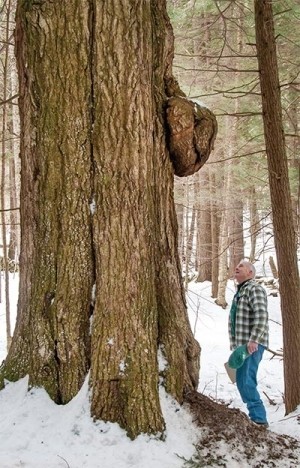A tree’s growth is based, in part, on competition from its neighbors. Its first priority is to gain access to the sun, and in a forest up is the only way to go. (An open grown tree will grow out – notice how a yard maple is all crown and no stem.)
But this explains why a tree grows tall, not how. How tall a tree will grow is dictated partly by its genes (you can coddle a pin cherry all you want, but it’ll never be as tall as even a runt black cherry.) The tallest trees in the northeast are white pines, attaining heights over 150 feet with the very tallest pushing 170 feet. Our tallest hardwood is white ash, capable of growing 150 feet tall.
A tree’s height is also dictated by environmental conditions. Most trees are capable of being taller than they actually are, they’re just limited by deficiencies in light, water, or nutrients.
The tallest trees on the planet are coast redwoods. Giant sequoias are, pound for pound, more massive (three times the mass of the largest animal, the blue whale) but still about an eastern tree shorter than the tallest redwoods. Indeed, the tallest known individual tree on Earth is a redwood, known by the nickname Hyperion. Measured at 379 feet, Hyperion is 209 feet taller than the very tallest tree known in New England.
Why are redwoods so much taller than our trees – and everyone else’s?
It comes down to water – not so much water supply, but the physics of moving water. We all know trees need water and that it comes from the ground. Transporting water from the roots, on through the trunk, and up to the leaves is a challenge. Unlike in animals, a tree’s vascular system has no heart; there is no pump of any kind. Water is not pushed up the tree. Instead, it is pulled from above: water molecules tend to stick to each other and to other substances. When moisture evaporates from the surface of a leaf, it pulls along a column of water that extends all the way back to the roots. The water is pulled from the soil to replace what was lost above. As a tree grows taller, it becomes increasingly difficult to get water to its topmost leaves. Eventually, this leads to drought stress and reduced photosynthesis and growth.
All trees have to deal with this reality of physics, but those lanky redwoods deal with it better than any others. And according to some researchers, their superiority may derive largely from the fog in which they live. Gigantic redwoods exist only in a narrow band along a few hundred coastal miles in northern California. They grow in wet temperate forests in steep valleys, buffered against wind, and receive well over 100 inches of precipitation annually. These forests are marked by consistently cool, moist conditions and an abundance of fog.
Evidently, redwoods are able to absorb water from fog directly into their leaves. According to the National Park Service, stewards of the tallest of them, fog accounts for 40 percent of a redwood’s moisture intake. So instead of fighting against the physics of pulling hundreds of gallons of water from the soil through the tree’s complex – and really long – vasculature, they avail themselves of a more handy source. With access to water in the fog right near the leaves, the plumbing problem becomes something of a plumbing advantage.
If snow, wind, drought, and blackflies conferred a physiological height advantage to trees, ours would be taller for sure.



Discussion *